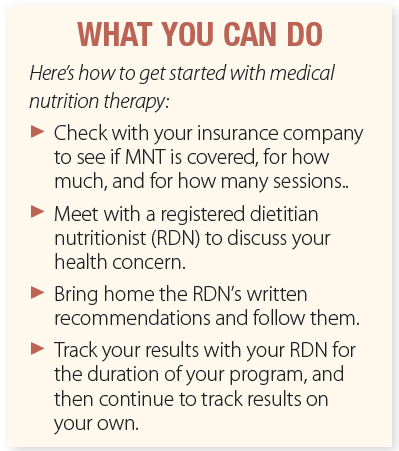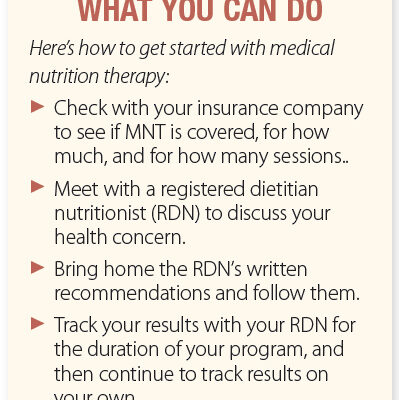Medical Nutrition Therapy Focuses on Eating to Improve Your Health
Does this scenario sound familiar? You see your doctor and discuss a medical condition you have, and your doctor advises you to eat healthier. This advice isn’t surprising, since following a healthy eating pattern has been shown to help everything from constipation and cancer to high blood pressure and heart disease.
But most of us don’t know what dietary changes will be most beneficial for our health, or how to go about making them. That’s where medical nutrition therapy (MNT) may help.
“MNT is a formal, structured assessment and diagnosis a registered dietitian nutritionist (RDN) uses for developing an individualized approach to managing a medical condition with nutrition care,” explains Beth McDonald, MS, RDN, a dietitian at Weill Cornell Medicine. “The most common medical conditions treated with MNT are chronic diseases like heart disease— including coronary artery disease, arrhythmias (irregular heartbeat), and contributing factors such as high blood pressure and high cholesterol—as well as prediabetes, diabetes, and malnutrition associated with cancer.”

What’s Involved with MNT
The process of MNT follows an acronym called ADIME: assessment, diagnosis, intervention, monitoring, and evaluation.
The process starts with a one-hour intake session, followed by a 15- to 30-minute follow-up session.
“During the initial intake, the RDN will identify the primary reason for your visit and collect information regarding your personal and family medical histories, as well as your current dietary and fitness regimens. He or she will also review relevant lab work if it’s available, and collect data such as height, weight, and other body mass measurements,” explains McDonald. This gives the RDN the information he or she needs to determine reasonable lifestyle goals that will help you manage your medical condition.
The next step is meeting with you to explain the goals and how to achieve them. McDonald says follow-up sessions are devoted to reviewing previous goals and discussing your progress; this may involve reviewing food and fitness journals along with symptom trackers.
McDonald emphasizes that MNT is not focused solely on nutrition; it takes a holistic approach to health that also includes a discussion about exercise, sleep, and stress management. “It’s all the factors that go into helping us support a person in making optimal choices,” McDonald explains.
Conditions That Benefit from MNT
“I would argue that MNT can be applied to most, if not all, medical conditions, because nutrition has a profound impact on all body systems,” McDonald says. “But the condition that has the most support for MNT is diabetes, which requires good management of blood sugar. For clients who have diabetes, we evaluate their trouble spots with blood sugar management, develop interventions best suited to help them reach their blood sugar goals, and then monitor and evaluate whether the intervention has been effective.”
As an alternate example, “If a woman came in with a diagnosis of high cholesterol, we would determine the saturated fat content of her diet, how much fiber she is consuming, and whether or not she is getting unsaturated, anti-inflammatory omega-3 fats,” McDonald explains. “Then we would develop a plan that sets a goal for reducing saturated fat (less meat and butter) and increasing high-fiber foods (whole grains and other plant foods) and foods with omega-3s, such as flaxseed, walnuts, and fatty fish (salmon, mackerel, tuna, sardines). At follow-up appointments, we would monitor her cholesterol levels and discuss dietary and other lifestyle changes she has made, as well as any additional changes that could provide further benefit.”
Program Timeline
Medical nutrition therapy is generally a short-term program, but it can vary depending on the problem being addressed.
“We identify the biggest problem areas and make adjustments that are effective and sustainable,” McDonald says. “If, for example, a client has Crohn’s disease or some other digestive condition, we might do a short-term elimination diet. That’s not intended to be a long-term change; it’s a therapeutic protocol to identify what triggers their symptoms. But the goal is always to find long-term solutions based on healthier behaviors.”
Insurance, Costs, and Getting Started
Many insurance companies will reimburse policyholders for MNT for certain conditions, especially those involving cardiometabolic health, such as high cholesterol, high blood pressure, high blood sugar, and obesity. (Costs can run from $150 to $450 per session.) Medicare covers MNT if you have diabetes or kidney disease, or if you have had a kidney transplant in the past three years, but you’ll need a doctor’s referral.
McDonald says you don’t necessarily have to have a diagnosed condition to benefit from MNT; for example, some people use MNT for help with obesity.
You can contact an RDN directly, or your primary care physician may provide a referral. McDonald notes it is common for specialists, such as cardiologists, endocrinologists, and gastroenterologists, to refer patients for MNT.
Even if you don’t have a medical condition, it may be worth your while to see a dietitian who can help you create a healthier eating pattern that supports better health, McDonald says. “There’s no preauthorization required, but I would recommend calling your insurance company to see if it’s covered.”
The post Medical Nutrition Therapy Focuses on Eating to Improve Your Health appeared first on University Health News.
Read Original Article: Medical Nutrition Therapy Focuses on Eating to Improve Your Health »


